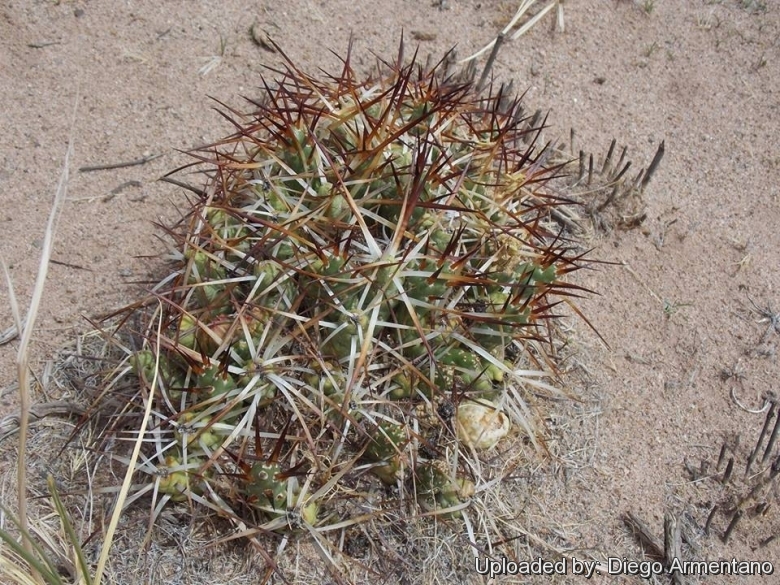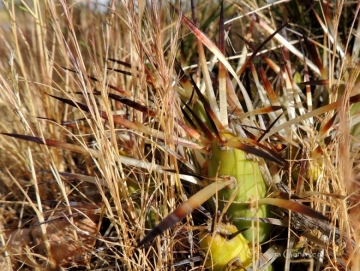
Maihueniopsis glomerata Photo by: Diego Armentano
In habitat near Salinas Grandes, province of Jujuy, Argentina. 3465 metres above sea level.
Origin and Habitat: Maihueniopsis glomerataSN|7342]]SN|7342]] occurs in Argentina from Catamarca, La Rioja, San Juan to Mendoza northwards into south Bolivia, and in Chile north-east of La Serena in the Coquimbo region.
Altitude range: This species grows at elevations of 500 to 4,000 metres above sea level.
Habitat and Ecology: The species grows in puna habitat. It occurs in sandy or clayey plains as well as in stony hills along with Cereus aethiopsSN|7679]]SN|6944]], Echinopsis leucanthaSN|8246]]SN|8246]], Eriosyce strausianaSN|18]]SN|18]], Opuntia sulphureaSN|32053]]SN|32053]] and TrichoSN'> 7680' alt='6944'>Cereus candicans#SN#7679'>Tricho[[Cereus candicansSN' style='border:none;'>. M. glomerata has a wide range, is common and locally abundant, occurs in protected areas and only very localized threats affect the species. There is no known use or trade for M. glomerata.
7680' alt='6944'>Cereus candicans#SN#7679'>Tricho[[Cereus candicansSN' style='border:none;'>. M. glomerata has a wide range, is common and locally abundant, occurs in protected areas and only very localized threats affect the species. There is no known use or trade for M. glomerata.
Synonyms:
See all synonyms of Maihueniopsis glomerata
back
Accepted name in llifle Database:Maihueniopsis glomerata (Haw.) R.KieslingDarwiniana 25: 202. 1984Synonymy: 22
back
Common Names include:
ENGLISH: Copana cactus
SPANISH (Español): Copana, Leoncito, Quepo, Quisco, Conoídeo
Description: Maihueniopsis glomerataSN|32593]]SN|7342]] (copana cactus) is a small cactus species forming low, spreading, strong-jointed, hemispheric clumps. It is a smaller and sometimes less spiny version of Maihueniopsis darwiniiSN|7342]]SN|20943]], with oval to elongated, egg-shaped stems either erect or prostrate. Throughout its natural range there is considerable variation in segment size, spine colour, spine count per areola etc. such that this species is now to be found under numerous, ill-defined varietal names in cultivation, but these all seem to be forms of this very variable species. Maihueniopsis glomerataSN|20943]]SN|7342]] resembles some forms of Opuntia fragilis in the shape and size of the joints or stems. It also has the ability to spread itself when loosely attached joints break away from the main plant and root wherever they land. It is interesting that O. fragilis has one of the most northern ranges in the cactus family, while M. glomerata has one of the most southern, being from Patagonia at the southern end of South America. It reproduces by seed and vegetatively by detachment of joints or portions of the plant, which can take root and establish themselves as independent individuals.
Root: It has a carrot-sized taproot.
Stems: Joints globular, to ovoid, pointed, 2-4(-5) cm long, often in cultivated specimens even smaller, dull greyish brown, hardly tuberculate except in drying.
Areoles: Small, about 20 per segment, felty, bearing numerous long, brown glochids, the uppermost 1-2 usually the spineless.
Leaves: Very small, early falling off.
Spines: Often wanting, when present 1 to 4. Principal spines 1-2 long, weak, narrowly flattened, thin and papery, more or less erect, straight or slightly defexed, hardly pungent, either white or brownish, sometimes 10 cm long. Secondary spines 0-2, bristle-like.
Flowers: Light yellow, to 5 cm long. Pericarpels obconical, with 15-18 areoles, those on the rim with bristles. Unlike Maihueniopsis nigrispinaSN|7342]]SN|32593]], it is not self fertile.
Fruit: Globose, spineless,1 to 1.5 cm long, green becoming yellow and dry when ripe, the largest containing up to 100 seeds in a lime-filled cavity.
Seeds: Corky, lenticular, creamy brown, 2.5 to 4 mm.
Taxonomy: The species Mahuieniopsis hypogaea (Werderm.) F.Ritter is considered separately and not part of M. glomerata (following Hunt et al. 2006). According to L. Faundez, P. Saldivia and H. Walter Mahuieniopsis camachoi (Espinosa) F.Ritter, Mahuieniopsis colorea (Backeb.) F.Ritter, Mahuieniopsis domeykoensis F.Ritter, Mahuieniopsis grandiflora F.Ritter and Mahuieniopsis wagenknechtii F.Ritter should all be considered as separate species, however, following Hunt et al. (2006) they are treated here under M. glomerata. The name Opuntia glomerata, has also been wrongly applied to Tephrocactus articulatusSN|7330]]SN|7330]].
Bibliography: Major references and further lectures
1) N. L. Britton, J. N. Rose: “The Cactaceae. Descriptions and Illustrations of Plants of the Cactus Family.” Vol I, The Carnegie Institution of Washington, Washington 1919
2) Leo J. Chance “Cacti and Succulents for Cold Climates: 274 Outstanding Species for Challenging Conditions” Timber Press, 19 June 2012
3) Trevisson, M., Lowry, M., Kiesling, R. & Méndez, E. 2013. Maihueniopsis glomerata. The IUCN Red List of Threatened Species. Version 2014.3. <www.iucnredlist.org>. Downloaded on 12 April 2015.
4) Edward Anderson “The Cactus family” Timber Press, Incorporated, 2001
5) James Cullen, Sabina G. Knees, H. Suzanne Cubey "The European Garden Flora Flowering Plants: A Manual for the Identification of Plants Cultivated in Europe, Both Out-of-Doors and Under Glass" Cambridge University Press, 11/Aug/2011
6) David R Hunt; Nigel P Taylor; Graham Charles; International Cactaceae Systematics Group. "The New Cactus Lexicon" dh books, 2006
7) “Description of New Succulent Plants of the Natural Order of Cacteae. (Decas duodecima novarum Plantarum Succulentarum).” In: Philosophical Magazine. 7: 111–118 1830.
8) EGGLI U, M MUÑOZ & B LEUENBERGER “Cactaceae of South America: The Ritter Collections.” Englera 16: 1- 646. (1995)
9) HOFFMANN A “Cactáceas en la flora silvestre de Chile”, 1ª ed. Fundación Claudio Gay, 272 pp. (1989)
10) KATTERMANN F “Observations of Chilean Opuntioideae Part III, Maihueniopsis.” Cactus and Succulent Journal 82:168-171. (2010)
11) KIESLING R, J LARROCA, L FAÚNDEZ, D METZING & S ALBESIANO “Cactaceae.” En: Zuloaga FO, M Belgrano & O Morrone (eds) "Catálogo de las Plantas Vasculares del Cono Sur (Argentina, Sur de Brasil, Chile, Paraguay y Uruguay). Volume 2. Dicotyledonae: Acanthaceae – Fabaceae (Abarema – Schizolobium)": 1715-1830. Monographs in Systematic Botany from the Missouri Botanical Garden 107. (2008)
12) RITTER F “Kakteen in Südamerika” Volume 3 Chile. Spangenberg. 857-1238. (1980)
 In habitat (Mendoza province, Argentina) Photo by: Carolina González
In habitat (Mendoza province, Argentina) Photo by: Carolina GonzálezSend a photo of this plant.The gallery now contains thousands of pictures, however it is possible to do even more. We are, of course, seeking photos of species not yet shown in the gallery but not only that, we are also looking for better pictures than those already present.
Read More... Cultivation and Propagation: Maihueniopsis glomerataSN|7342]]SN|7342]] is an easy-to-grow plant supposed to be quite cold-hardy in the central European countries. It can survive outside in the garden in the sunny rockery on a sheltered place, but only if it's protected with a sheet of glass during the wintertime. It is also very good for a pot which can be stored inside an unheated greenhouse or on a balcony, somewhat protected from moisture during the winter, but is probably safest to grow it in the Alpine House or in a raised bed inside an unheated greenhouse all year around, with lots of ventilation. It, too, deserves to be drawn to the attention of trough enthusiasts, as it is a unique and attractive miniature that could remain in the same container for life. The plant is very slow growing besides being small.
Potting medium: It has a carrot-sized taproot and does best in garden loam that is gritty, but not rocky. In pots use a cactus mix or add extra perlite or pumice to regular soil potting soil. A gritty, very free-draining compost is suitable, and clay pots help the plants to dry out between watering. For best results, use a deep pot. We suggest repotting every 2-3 years.
Fertilization: During the beautiful season it’s good to enrich the soil of our succulent plants; using a fertilizer rich in potassium and phosphorous, but poor in nitrogen, because this chemical element doesn’t help the development of succulent plants, making them too soft and full of water.
Hardiness: It doesn't fear cold weather and it bears very harsh frost, and temperatures of around -10° degrees Celsius did not harm these plants at all. They should not be kept hot in summer as they are from high elevations. In its high mountain habitats this charming, little cactus is often buried under snow for long periods of winter. It does not require such a covering, but the plant is better able to survive without cold damage when a layer of mulch protects it if there is not snow cover during the harshest months.
Sun Exposure: It is essential to give full sun; otherwise they will become atypical. If grown in full sun, the new growth will flower profusely in spring and summer.
Watering: These plants only from time to time if grown outdoors, but it should be watered abundantly if grown in a pot or in the greenhouse, during the summer. Like most alpine plants, it should not be kept excessively dry in summer.
Pest and diseases. The spring weather, with a high temperature swing between the day and night hours, and pretty frequent rains, can favour the development of fungus diseases, which should be treated pre-emptively with a systemic fungicide.











